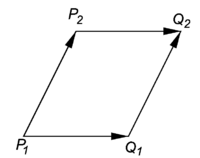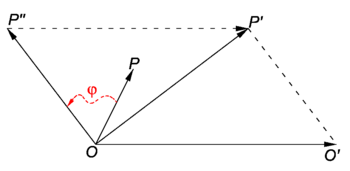Affine space: Difference between revisions
imported>Paul Wormer |
imported>Paul Wormer |
||
| Line 129: | Line 129: | ||
Let ''P'' → ''P''′ be a mapping of the affine space ''A'' into itself; if the map satisfies the following two conditions, it is an ''affine map''. | Let ''P'' → ''P''′ be a mapping of the affine space ''A'' into itself; if the map satisfies the following two conditions, it is an ''affine map''. | ||
(i) Conserve "parallelism". (In the Euclidean plane this condition implies that sets of mutually parallel arrows are mapped onto sets of mutually parallel arrows. Note, however, that in general the mapped arrows are not parallel to the original arrows | (i) Conserve "parallelism". (In the Euclidean plane this condition implies that sets of mutually parallel arrows are mapped onto sets of mutually parallel arrows. Note, however, that in general the mapped arrows are not parallel to the original arrows): | ||
:<math> | :<math> | ||
\overrightarrow{P_1 Q_1} = \overrightarrow{P_2 Q_2}\quad \Longrightarrow\quad | \overrightarrow{P_1 Q_1} = \overrightarrow{P_2 Q_2}\quad \Longrightarrow\quad | ||
| Line 147: | Line 147: | ||
\phi(\overrightarrow{P_1 Q_1})\equiv \overrightarrow{P'_1 Q'_1} = \overrightarrow{P_1 Q_1}. | \phi(\overrightarrow{P_1 Q_1})\equiv \overrightarrow{P'_1 Q'_1} = \overrightarrow{P_1 Q_1}. | ||
</math> | </math> | ||
Here the origin and the image are parallel. | |||
[[Image:Affine map.png|right|thumb|350px|Fig. 1. Affine map. Here φ is linear, but not necessarily length preserving.]] | [[Image:Affine map.png|right|thumb|350px|Fig. 1. Affine map. Here φ is linear, but not necessarily length preserving.]] | ||
Given two points ''O'' and ''O''′ and a linear map φ: ''V'' → ''V''. There exists exactly one affine map that sends ''O'' into ''O''′ and induces φ on ''V''. This is the map | Given two points ''O'' and ''O''′ and a linear map φ: ''V'' → ''V''. There exists exactly one affine map that sends ''O'' into ''O''′ and induces φ on ''V''. This is the map | ||
:<math> | :<math> | ||
\overrightarrow{OP\,'} = \overrightarrow{OO'} + \ | \overrightarrow{OP\,'} = \overrightarrow{OO\,'} + \varphi(\overrightarrow{OP}) , | ||
</math> | </math> | ||
because (see Fig. 1), | because (see Fig. 1), | ||
:<math> | :<math> | ||
\begin{align} | \begin{align} | ||
\ | \varphi(\overrightarrow{OP}) &= \overrightarrow{OP\,''}\\ | ||
\overrightarrow{P''P\,'} &= \overrightarrow{OO\,'}\\ | |||
\overrightarrow{OP\,'} &= \overrightarrow{P''P'} + \overrightarrow{OP''} = | \overrightarrow{OP\,'} &= \overrightarrow{P''P\,'} + \overrightarrow{OP''} = | ||
\overrightarrow{OO'} + \varphi(\overrightarrow{OP}) . | \overrightarrow{OO\,'} + \varphi(\overrightarrow{OP}) . | ||
\end{align} | \end{align} | ||
</math> | </math> | ||
Choose a basis | |||
:<math> | |||
(O; \,\vec{e}_1, \vec{e}_2,\ldots, \vec{e}_n) | |||
</math> | |||
then | |||
:<math> | |||
\overrightarrow{OP\,'} = \sum_{i=1}^n p'_i \vec{e}_i, \qquad | |||
\overrightarrow{OO\,'} = \sum_{i=1}^n t_i \vec{e}_i, \qquad | |||
\varphi(\overrightarrow{OP}) = \sum_{i=1}^n \vec{e}_i\sum_{j=1}^n F_{ij} p_j, | |||
</math> | |||
from which follows | |||
:<math> | |||
p'_i = t_i +\sum_{j=1}^n F_{ij} p_j, \quad i=1,\ldots,n \quad\Longleftrightarrow\quad | |||
\mathbf{p}' = \mathbf{t} + \mathbf{F} \mathbf{p} | |||
</math> | |||
'''To be continued''' | '''To be continued''' | ||
Revision as of 05:36, 12 November 2008
The 2-dimensional plane, well-known from elementary Euclidean geometry, is an example of an affine space.
From elementary geometry we know that any two points in a plane (a collection of infinitely many points) can be connected by a line segment. If the points P and Q in a plane are ordered with P before Q, the line segment connecting the two becomes an arrow pointing from P to Q. This arrow can be mapped onto a vector, the difference vector, denoted by .[1] If all arrows in a plane can be mapped onto vectors of a 2-dimensional vector space V2, called the difference space, the plane is an affine space of dimension 2, denoted by A2. Arrows that are mapped onto the same vector in the difference space are said to be parallel, they differ from each other by translation.
In elementary geometry, the map of arrows onto vectors is almost always defined by the choice of an origin O, which is a point somewhere in the plane. Clearly, an arbitrary point P is the head of an arrow with tail in the origin and corresponding with the unique difference vector . All arrows with tail in O are mapped one-to-one onto a 2-dimensional difference space V2, with the vector addition in V2 in one-to-one correspondence with the parallelogram rule for the addition of arrows in the plane.
Usually one equips the difference space with an inner product, turning it into an inner product space. Its elements have well-defined length, namely, the square root of the inner product of the vector with itself. The distance between any two points P and Q may now be defined as the length of in V2. A two-dimensional affine space, with this distance defined between the points, is the Euclidean plane known from high-school geometry.
Upon formalizing and generalizing the definition of affine space, we replace the dimension 2 by an arbitrary finite dimension n and replace arrows by ordered pairs of points ("head" and "tail") in a given point space A. Briefly, A is an affine space of dimension n if there exists a map of the Cartesian product, A × A onto a vector space of dimension n. This map must satisfy certain axioms that are treated in the next section. If the dimension needs to be exhibited, we may write An for the affine space of dimension n.
Formal definition
We will restrict the definition to vector spaces over the field of real numbers.
Let V be an n-dimensional vector space and A a set of elements that we will call points. Assume that a relation between points and vectors is defined in the following way:
- To every ordered pair P, Q of A there is assigned a vector of V, called the difference vector, denoted by .
- To every point P of A and every vector of V there exists exactly one point Q in A, such that .
- If P, Q, and R are three arbitrary points in A, then
If these three postulates hold, the set A is an n-dimensional affine space with difference space V.
Two immediate and important consequences are:
Lemma 1:
- .
Proof: If the points coincide, , we just saw that the difference vector is the zero vector. Conversely, assume that and . Then for an arbitrary point ,
which implies that the same vector in V connects in A with two different points, which by postulate 2 is forbidden.
Parallelogram law
Consider four points in A: P1, P2, Q1, and Q2. Assume that the following difference vectors are equal,
then we my exchange Q1 and P2,
See the figure for a concrete example in which the four points form a parallelogram.
Proof: Subtract the following equations:
This gives
Position vector
Choose a fixed point O in the affine space A, an origin. Every point P is uniquely determined by the vector . Indeed, suppose that there is another point Q such that , it then follows from lemma 1 that P = Q.
The vector is the position vector of P with respect to O. After choosing O every point P in A is uniquely identified by its corresponding position vector .
Choice of another origin O ′ gives a translation of by , for
with the position vector of P with respect to O ′.
Affine coordinate systems
An affine coordinate system
consists of an origin O in A and a basis of the difference space V. Then every point P in A determines a system of n real numbers xi (i = 1, ..., n) by
The numbers xi (i = 1, ..., n) are the affine coordinates of P with respect to the given coordinate system. Note that O has the coordinates xi = 0.
Consider now two different affine coordinate systems,
Write
The matrix (Ai j) transforms the one basis of V into the other, hence it is a square regular (invertible) matrix. The real numbers ti are the affine coordinates of O′ relative to .
Express a fixed point P with respect to and ,
Insert into the second equation
and express in , then
so that the transformation from the one affine coordinate system to the other is,
where we introduced bold lowercase letters for real column-vectors (stacks of n real numbers) and the boldface capital indicates an n × n matrix. Inversion of the non-singular (regular) matrix (Ai j) gives the inverse transformation,
Affine maps
Let P → P′ be a mapping of the affine space A into itself; if the map satisfies the following two conditions, it is an affine map.
(i) Conserve "parallelism". (In the Euclidean plane this condition implies that sets of mutually parallel arrows are mapped onto sets of mutually parallel arrows. Note, however, that in general the mapped arrows are not parallel to the original arrows):
(ii) The map is linear in the difference space. That is, the map φ: V → V defined by
is linear.[2] A translation is an affine map with φ the identity operation,
Here the origin and the image are parallel.
Given two points O and O′ and a linear map φ: V → V. There exists exactly one affine map that sends O into O′ and induces φ on V. This is the map
because (see Fig. 1),
Choose a basis
then
from which follows
To be continued
Notes and references
- A. Lichnerowicz, Elements of Tensor Calculus, Translated from the French by J. W. Leech and D. J. Newman, Methuen (London) 1962.
- W. H. Greub, Linear Algebra, 2nd edition, Springer (Berlin) 1963.

















































